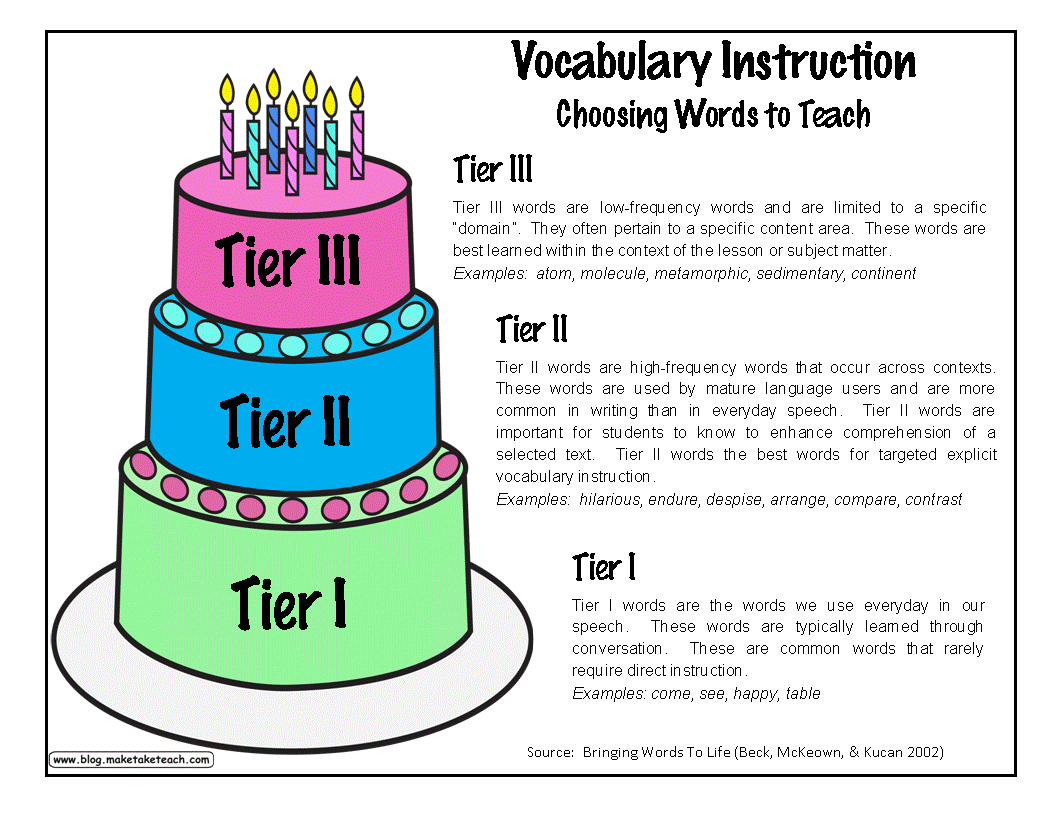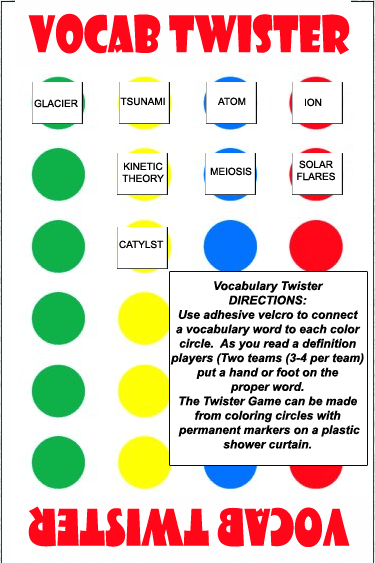
Vocabulary
Learning Vocabulary
Vocabulary is learned in basically three ways: by hearing it around us (conversation, interaction, by others speaking it near us, etc.), by reading it (instructional texts, novels, magazines, etc.), and by learning it from teachers through instruction. So, this means it is crucial that teachers understand that they must include direct instruction on vocabulary in the classroom.
With this in mind, teachers can improve reading instruction by vocabulary and vise-versus. Reading and Vocabulary go hand and hand with one another. Vocabulary is included in the 5 Pillars of Reading Instruction, which includes these 5 Pillars:
-
Phonics
-
Phonemic Awareness
-
Vocabulary
-
Fluency
-
Comprehension
Students, especially Emergent Bilinguals, must learn vocabulary. Wright explains that "ELLs must rapidly develop their English vocabulary knowledge or else they will fall further behind their English-speaking peers" (Wright, 160). Wright goes on to say that the more words they know, the more they will be able to speak and understand what they read in English. With Emergent Bilinguals, they can also be able to associate the vocabulary they learn to their own home language. Vocabulary instruction can help students with their understanding of what they are reading and hearing, and even the context of what they are learning. So, we as teachers must continue to teach vocabulary in our classrooms.
So how do teachers teach vocabulary? Let's find out!

Teaching Vocabulary
Wright shares Marzano and Pickering's six steps to teaching new vocabulary words to ELLs (Wright, 161). They are as follows:
-
Provide a description, explanation, or example of the new term (along with non-linguistic representations, such as pictures).
-
Ask students to restate the description, explanation, or example in their own words.
-
Ask students to construct a picture, symbol, or graphic representing the term or phrase.
-
Engage students periodically in activities that help them add to their knowledge or the terms in their notebooks.
-
Periodically ask students to discuss the terms with one another.
-
Involve students periodically in games that allow them to play with terms.

The ways that teachers can also create strong vocabulary instruction is by:
-
Connecting words to other concepts and words they are using (whether that is through their home language or in other words and concepts they have already learned in English)
-
Choosing words from Tiers 2 and 3 words (look below for Vocabulary Tiers) that are content specific that are applicable
-
Give students many opportunities to use the words
-
Directly teaching the words by:
-
introducing it in a student-friendly way,
-
using it in context,
-
connecting it to the students' background and experiences, and
-
teaching it hands-on (with objects)
-
-
Having the students do it, and having them experience the word in context
-
Provide pictures and visuals with the vocabulary, and have the students create their own visuals and graphics
-
Use gestures to go along with the vocabulary
-
Use repetition to go from “kind of knowing a word” to using words in ways that are “specific, precise and flexible”
Overall, teaching vocabulary needs to be intentional, frequent, and relevant. Emergent Bilinguals need to learn vocabulary in order to build their reading comprehension and writing skills. Teaching vocabulary also needs to have a deeper meaning, that connects the content to the students' lives. Teachers need to make sure to use strategies for learning words, such as the Six-Step Vocabulary Process.
Robust Instruction
Colombo discusses Robust Instruction as "one strategy in a multi-strategy program to develop vocabulary". It is also said to improve the verbal ability of ELLs and FEP learners, and helps them learn new words to build more than target vocabulary. So, ELLs and FEP learners generate more words that further expand their vocabulary than just the target vocabulary (Colombo, 133).

Words Worth Teaching
Human beings learn all through what we hear and what we are taught. Some words are more important to be actually taught more than others. So, what words do we as teachers need to teach?
There are three different types of vocabulary words. They are Tier 1: Basic Vocabulary, Tier 2: High Frequency/Multiple Meaning, and Tier 3: Subject Related. The types of words that we should focus on teaching is Tiers 2 and 3 words. Tier 1 words are common, and many students learn them through conversation and exposure, while Tiers 2 and 3 words need more instruction for students to be able to use and understand them.
You can find all of this information on the document below: "Three Tiers of Vocabulary and Education" by Thaashida L. Hutton.
Tier 1
-
Basic Words
-
Rarely require direct instruction (teaching)
-
Typically do not have multiple meanings
-
Includes:
-
Sight words
-
Nouns
-
Verbs
-
Adjectives
-
Early reading words
-
-
Examples: book, sad, girl, dog, orange
Tier 2
-
High Frequency Words
-
Contain multiple meanings
-
Important for reading comprehension
-
Increased descriptive vocabulary
-
Words that allow students to describe concepts in a detailed manner
-
-
Occur across a variety of domains
-
Occur in nature language situations
-
Adult conversations
-
Literature
-
-
Important for direct instruction
-
Indicators of student progress
-
-
Examples: fortunate, benevolent, masterpiece, measure, industrious
Tier 1
-
Low Frequency Words
-
Occur in specific domains
-
Subjects in school
-
Hobbies
-
Occupations
-
Geographic regions
-
Technology
-
Weather
-
-
Learn these words when their is a specific need
-
Examples: economics, asphalt, isotope, Revolutionary War

How to Choose Vocabulary Words
(Colombo, 133)
-
Is the word important to understanding the text?
-
Does the word represent a specific concept that students must know?
-
Can students use text context or structural analysis to determine the meaning of the word?
-
Can study of this word enhance students' structural analysis or dictionary skills?
-
Is the word useful beyond the present reading selection?
-
Will learning this word spark students' interest in learning words?
Activities to Teach Vocabulary
There are so many ways that teachers can incorporate vocabulary into the classroom.
-
Down below, there is a link to 20 Vocabulary Activities and 23 Effective Vocabulary Activities. It includes activities called Pair-Define-Explain, Vocabulary Bingo, Word Up!, and more.
-
Also down below is a link to the Teaching Channel website, which has a video of a 7th grade classroom doing a fun activity related to vocabulary in the Gettysburg Address. In the video, the students in the class have clues for each vocabulary word. They then have to guess which words from the Gettysburg Address is the mystery word.
-
I linked my vocabulary activity page also, which is where I went into depth with an activity I would use in the classroom in order to boost vocabulary development.
-
Examples of some activities teachers can use in the classroom:
-
Vocabulary Four Square: Students have to do a definition in their own words, draw a picture, use it in a sentence, and then write a sentence or draw what the opposite of what that word would be.
-
Reader's Theater: Students are able to act out the words that stye hear and read in a play format. Each student can play a different character, and they have to be able to understand the words to act them out accordingly. So, they will practice what they will be saying and talk with their group members about the unknown words first before they actually act it out.
-
Semantic Map: Students will create a mind map with their vocabulary word by connecting related words and concepts to it and categorizing it. They can use pictures, too.
-
Other Fun Examples:




Citations:
-
Arizona Department of Education. (n.d.). Read Aloud. Retrieved March 31, 2019, from https://www.azed.gov/read20/read-aloud/
-
Colombo, M. "Teaching English Language Learners." Teaching English Language Learners : Michaela Colombo : 9781412980296. SAGE Publications Inc, 17 May 2011. Web. 31 Jan. 2017. https://www.bookdepository.com/Teaching-English-Language-Learners-Michaela-Colombo/9781412980296
-
Julie. (2013, February 11). The Need for Explicit Vocabulary Instruction. Retrieved March 31, 2019, from http://blog.maketaketeach.com/the-need-for-explicit-vocabulary-instruction/
-
Larson, J. (1970, January 01). 23 Effective Vocabulary Activities. Retrieved March 31, 2019, from https://www.upperelementarysnapshots.com/2017/06/23-effective-vocabulary-activities.html
-
Pocketful of Primary. (2017, January 16). 5 Tips for Teaching Vocabulary. Retrieved March 31, 2019, from https://youtu.be/yCmRKkvxxlo
-
Teaching Channel. (2018, September 07). Extending Understanding: Vocabulary Development. Retrieved March 31, 2019, from https://www.teachingchannel.org/video/middle-school-vocabulary-development
-
Vocabulary. (n.d.). Retrieved March 31, 2019, from https://pop.education.gov.il/tchumey_daat/english/yesodi/study_topics/vocabulary/
-
Wright, W. E. (2015). Foundations for teaching English language learners: Research, theory, and practice (2nd ed.). Philadelphia: Caslon.